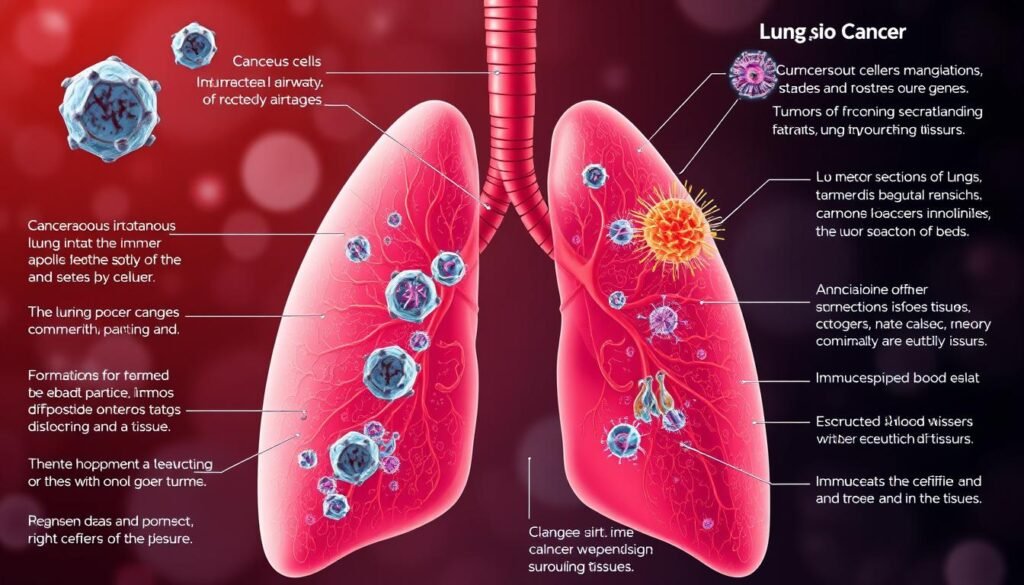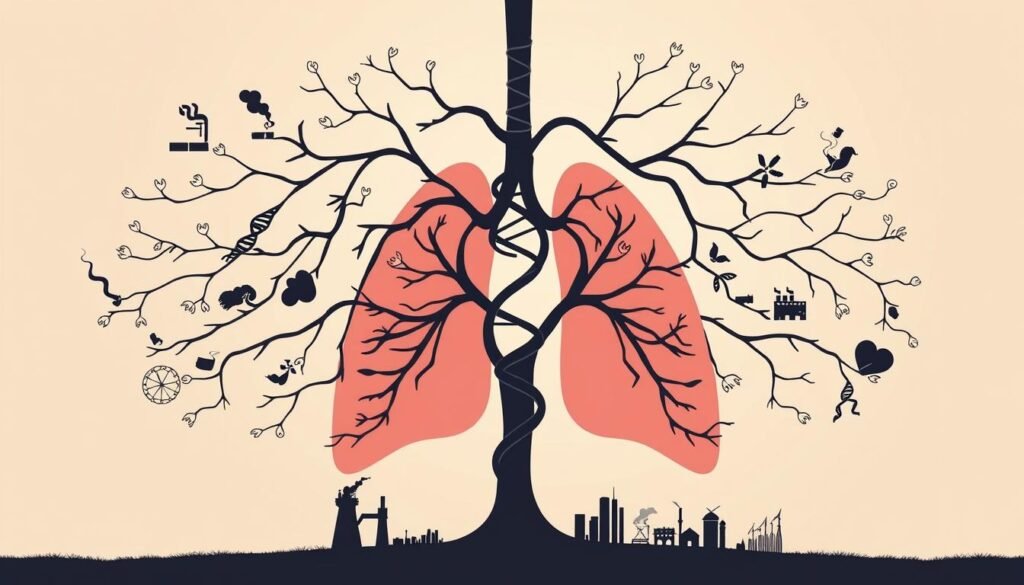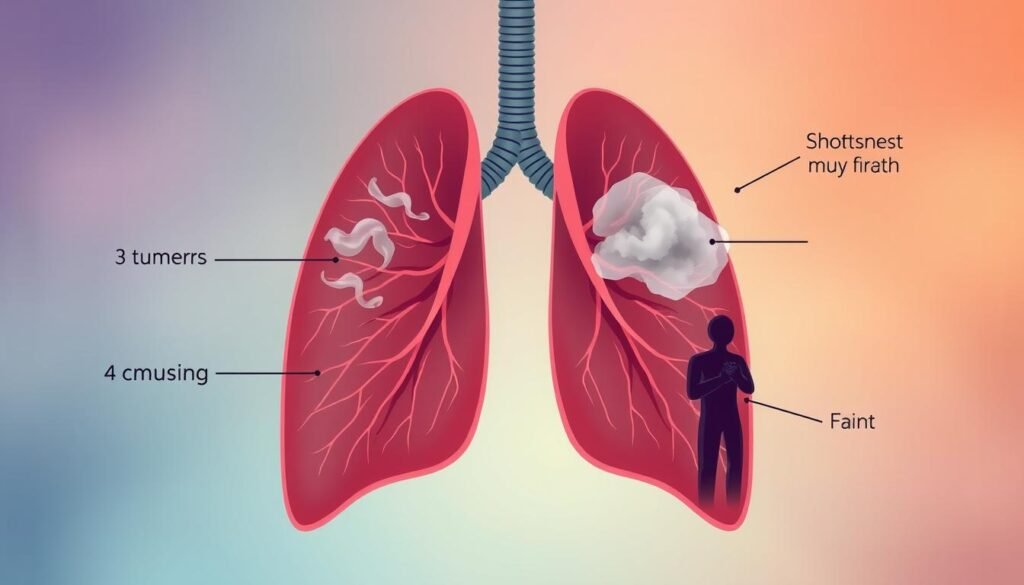Since 1987, lung cancer has caused more deaths among women than breast cancer. This fact shows the urgent need to understand this illness. In the US, about 225,000 new lung cancer cases arise yearly. Sadly, these contribute to roughly 160,000 deaths every year. Lung cancer’s pathophysiology includes complex changes in lung cells. These lead to tumor growth and reduced lung function. Our goal is to explore the complex development of lung cancer. We will look at its types, causes, risk factors, and treatments. This will help combat the world’s leading cause of cancer deaths.
Key Takeaways
- Lung cancer causes more deaths in women than breast cancer.
- There are about 225,000 new lung cancer cases in the U.S. each year.
- Primary smoking is responsible for around 90% of lung cancer cases.
- Exposure to asbestos and radon significantly increases lung cancer risks.
- Understanding the pathophysiology of lung cancer is essential for developing effective treatment options.
- Genetic mutations play a critical role in the development of lung cancer.
Introduction to Lung Cancer
Lung cancer is a major global health issue. It grows uncontrollably in the lungs. It’s one of the top reasons people die from cancer worldwide. Knowing about lung cancer is vital. Lung cancer overview helps us understand its impact. Also, keeping up with lung cancer statistics helps in catching it early.
In the U.S., adenocarcinoma is the most common lung cancer. Smoking mainly causes small cell lung cancer. This shows why stopping smoking is crucial. About 5% of cases are rare cancers like mesothelioma. Other types, like carcinoid and mediastinal tumors, need different treatments.
According to lung cancer statistics, smoking causes 90% of cases in men and 80% in women. Jobs that expose people to harmful substances also play a big role. So does living in polluted areas. Catching lung cancer early is key to treating it well.
This article gives a detailed look at lung cancer. It covers types, causes, risks, and how to treat them. Being aware and informed is critical in fighting this harmful disease.
What is Lung Cancer?
Lung cancer, known as bronchogenic carcinoma, is a major health issue worldwide. It starts in the lung’s tissues or airways. It causes malignant cells to grow out of control. We recognize two main kinds: non-small cell lung cancer (NSCLC) and small cell lung cancer (SCLC). NSCLC makes up about 85% of cases. Reading about lung cancer helps us understand how to tackle it properly.
Global Impact and Statistics
Lung cancer has a huge global impact, accounting for 12.4% of all new cancer cases each year. In the U.S., it’s the top cause of cancer deaths. Every year, about 234,000 people get diagnosed, and over 160,000 die. Here are some important stats:
| Statistic | Value |
|---|---|
| Global new cases annually | 1,350,000 |
| Global lung cancer deaths annually | 1,180,000 |
| 5-year survival rate in the U.S. | 15.6% |
| Percentage of lung cancer deaths in the U.S. (men) | 28% |
| Percentage of lung cancer deaths in the U.S. (women) | 26% |
| Incidence rate in men (per 100,000) | 75.2 |
| Incidence rate in women (per 100,000) | 52.3 |
Today, many lung cancer cases are in developing nations. Tobacco use and pollution are big reasons why. This shows how vital it is to boost lung cancer awareness and prevention globally.
Types of Lung Cancer
Lung cancer comes in two main types: non-small cell lung cancer (NSCLC) and small cell lung cancer (SCLC). Each type is unique and makes up most lung cancer cases. Knowing the differences helps doctors diagnose and treat the disease.
Non-Small Cell Lung Cancer (NSCLC)
About 80 to 85% of lung cancer cases are NSCLC. This group has various types like adenocarcinoma, squamous cell carcinoma, and large cell carcinoma. Adenocarcinoma is often found in the lung’s outer areas, starting from mucus-secreting cells. Squamous cell carcinoma forms near the lung center, from flat cells lining the airways.
Large cell carcinoma has big cancer cells and grows quickly, making fast diagnosis key.
- Adenocarcinoma: The most common, 40% of NSCLC cases.
- Squamous Cell Carcinoma: Makes up about 30% of NSCLC.
- Large Cell Carcinoma: Known for its aggressive growth.
Lesser-known types include Pancoast and carcinoid tumors. Pancoast tumors form at the lung’s apex and need special treatments. Carcinoid tumors grow slowly and surgery often works well.
Small Cell Lung Cancer (SCLC)
About 15 to 20% of lung cancers are SCLC. This kind, linked with smoking, grows fast. Its cells quickly divide, leading to large tumors. Early detection is critical for managing SCLC due to its speedy spread.
To sum up, distinguishing between NSCLC and SCLC, and the types within NSCLC, is crucial for proper treatment.
Pathophysiology of Lung Cancer
Lung cancer begins with genetic changes and harmful environments. These factors mess up how cells grow, leading to cancer. Carcinogens, like in cigarette smoke, are key to starting lung cancer mechanisms. Early contact with these harms can change DNA in important genes.
These DNA changes mess up normal cell growth. This causes cells to grow wildly, which is what happens in cancer. It was discovered back in the late 1920s that tobacco smoke is linked to lung cancer. Being around carcinogens a lot, plus other risks like asbestos and radon, ups the chances of getting lung cancer.
Genes also matter a lot in lung cancer. Scientists found a gene area on chromosome 6q23–25 that makes lung cancer more likely. If your family has a history of lung cancer, your own risk is higher. This is an important fact for genetic counseling.
To really understand lung cancer, it helps to know about its pathophysiology. This gives clues on how to prevent and manage it.

Causes of Lung Cancer
Lung cancer has several key causes. Knowing them helps in prevention and treatment. Tobacco smoke, radon exposure, and asbestos significantly increase lung cancer risks. Each plays a big role in the odds of getting this disease.
Primary Causes: Tobacco Smoke
Tobacco smoke is the top risk factor. It’s linked to 80% to 90% of lung cancer deaths. Smokers are much more likely to get lung cancer than non-smokers. The harmful substances in cigarette smoke damage lung cells. This leads to genetic changes and cancer. Non-smokers exposed to secondhand smoke also face higher risks.
Environmental Factors: Radon and Asbestos
Radon is the second leading lung cancer cause in the U.S., especially for non-smokers. It’s a radioactive gas found in homes. About one in every 15 homes in the country has radon issues. Testing and proper ventilation can reduce radon levels. Asbestos is another big risk, mainly at work. It’s carcinogenic and increases lung cancer risk, showing the need for workplace safety.
To really understand these causes, we must look at how they’re connected. A detailed overview is available here. It covers not just smoke, radon, and asbestos but also other environmental risks. This helps us see the big picture of lung cancer causes.
Risk Factors Associated with Lung Cancer
Lung cancer comes from various risk factors. Some are genetic while others are due to the environment and jobs. Knowing these factors helps us understand how lung cancer starts. It also helps in finding ways to prevent it.
Genetic Mutations and Inherited Risks
Studies show that genes play a big role in lung cancer risk. Certain gene changes, especially in genes like RB1 and TP53, increase lung cancer risk. This is more so for people with lung cancer in their family. If two or more close family members have had it, the risk is even higher. This is why genetic counseling is crucial for those with a family history of lung cancer.
Other Environmental and Occupational Risks
There are many non-genetic factors too. For example, workers exposed to asbestos face a high risk of lung cancer. About 70-80% of mesothelioma cases are linked to asbestos. Radon exposure is tied to about 30% of lung cancer deaths in non-smokers. Air pollution and diesel fumes also add to the risk. Conditions like COPD and fibrosis make people more likely to get lung cancer.

Development and Progression of Lung Cancer
Lung cancer begins with deep changes at the cellular level and can spread throughout the body. Knowing about these changes is key to understanding how serious lung cancer can be. It also shows why finding the right treatment is so important.
Cellular Changes Leading to Cancer
Certain things we breathe in can cause harmful changes in our lungs. These early changes can slowly become more dangerous. Without treatment, these cells can grow out of control.
Lung cancers grow at different rates. Sadly, most people don’t know they have lung cancer until it’s very advanced. By then, treatment options are limited.
Metastasis: How Lung Cancer Spreads
Metastasis makes lung cancer more deadly. Cancer cells break away and travel through the blood to new places. They often go to the brain, liver, bones, and other organs. This spread is why lung cancer is hard to catch early.
If cancer reaches the brain, people usually have only a few months left. This fact shows how tough it is to fight lung cancer once it spreads.
The following table sums up important points about lung cancer growth and spread:
| Parameter | Details |
|---|---|
| Types of Lung Cancer | Small Cell Lung Cancer, Non-Small Cell Lung Cancer |
| Common Metastasis Sites | Brain, Bones, Liver, Adrenal Glands |
| Average Survival After Brain Metastasis | 7-12 months |
| Stage 4 Lung Cancer Survival Rate | 3-7% |
| Lung Cancer Incidence in the US (2019) | 228,150 new cases |
| Global Lung Cancer Diagnoses (2018) | 2.1 million |
| Five-Year Overall Survival Rate | 19% |
| Five-Year Survival Rate (NSCLC vs SCLC) | NSCLC: 23%, SCLC: 6% |
Symptoms of Lung Cancer
Knowing the signs of lung cancer is key for getting help early. While many people don’t show symptoms at first, some do. It’s important to know early and late signs of lung cancer to help treatment work better.
Initial Symptoms vs. Advanced Symptoms
Early signs of lung cancer may not seem serious. They can look like symptoms of other, less serious illnesses. Some main symptoms are:
- Persistent or worsening cough
- Coughing up blood or bloody mucus
- Shortness of breath
- Chest pain, especially when you take deep breaths
- Hoarseness
- Not feeling hungry and losing weight without trying
- Feeling very tired and getting sick a lot
When lung cancer gets worse, other symptoms may appear. These include:
- Swollen lymph nodes
- Pain in the bones
- Changes in how your nervous system works
- Jaundice
- Swelling in your face and neck, trouble breathing, and headaches as part of superior vena cava syndrome
Importance of Early Detection
Finding lung cancer early can really help treatment work well. Screening tests, like low-dose CT scans, can spot lung cancer soon. People who smoke a lot or are between 55 and 80 should get checked often.
If you see any signs of lung cancer, seeing a doctor right away is crucial. Quick check-ups can help catch the disease early. This can lead to better chances of getting better.

| Symptom | Notes |
|---|---|
| Persistent Cough | May last for over eight weeks and worsen over time. |
| Coughing Up Blood | Commonly a key indicator of lung issues. |
| Chest Pain | Can feel tight and painful, especially with deep breaths. |
| Shortness of Breath | Due to airway narrowing from tumors. |
| Hoarseness | Caused by interference with vocal cords. |
| Loss of Appetite/Weight Loss | Unexplained weight loss is often concerning. |
| Recurring Respiratory Infections | May lead to bronchitis or pneumonia. |
Treatment Options for Lung Cancer
Lung cancer treatments change based on cancer’s type, stage, and patient health. They may include various treatments, suited to each person, to help increase success.
Surgical Interventions
Surgery is key in treating early-stage lung cancer. Types of surgery may include:
- Lobectomy: Removing a lung lobe.
- Pneumonectomy: Taking out a whole lung.
- Wedge resection: Cutting out a small, wedge part of the lung.
- Segmental resection: Taking out a big lung section with one or more lobules.
For localized non-small cell lung cancer (NSCLC) at stage I or II, surgery is often the best choice.
Chemotherapy and Radiation Therapy
After surgery, lung cancer patients might get chemotherapy. It uses drugs to kill fast-growing cells. Radiation may be added to kill more cancer cells. It can shrink tumors before or zap remaining cells after surgery.
Methods like stereotactic body radiotherapy deliver targeted radiation quickly, in just a few sessions.
Targeted Therapy and Immunotherapy
Targeted therapy attacks cancer’s specific genetic changes. It’s good for advanced cancer that’s returned or spread. Immunotherapy boosts your immune system to fight cancer. It’s an option when surgery isn’t possible.
Both treatments are breakthroughs, offering better life quality and longer survival.
Current Research and Future Directions in Lung Cancer
The search for lung cancer solutions is making great strides. Scientists look into many methods like new drug combos and checking our genes. These efforts may help catch the disease early and treat it in a way unique to each person.
Innovative Treatments and Discoveries
Machine learning is showcasing its power by spotting lung cancer early with a 97% accuracy. However, treatments like immunotherapy only help a few people right now. They include exciting options such as pembrolizumab (Keytruda) and nivolumab (Opdivo). These are used in the early stages of a common kind of lung cancer.
- Alectinib (Alecensa) gives patients more time without the disease coming back compared to the usual chemo in early stages.
- Osimertinib (Tagrisso) goes after certain gene changes in early-stage patients.
- The mix of dabrafenib (Tafinlar) and trametinib (Mekinist) shows promise for lung cancer with specific gene changes.
Ongoing Clinical Trials
Clinical trials are key in finding new lung cancer cures. They test things like combining ramucirumab (Cyramza) with pembrolizumab against standard treatments for a harsh form of lung cancer. Research funded by the National Cancer Institute (NCI) digs into everything from cell biology to bigger studies. This work is opening new doors in what we know about lung cancer.
| Treatment | Approval Status | Specific Targets |
|---|---|---|
| Pembrolizumab (Keytruda) | Approved | Early-stage NSCLC, adjuvant |
| Osimertinib (Tagrisso) | Approved | EGFR mutations, early-stage NSCLC |
| Alectinib (Alecensa) | Approved | Early-stage NSCLC |
| Dabrafenib (Tafinlar) | Approved | BRAF mutations, NSCLC |
| Trametinib (Mekinist) | Approved | BRAF mutations, NSCLC |
| Ramucirumab (Cyramza) | In Trials | Advanced NSCLC, combination therapy |
Conclusion
The world of lung cancer is complex. It includes how the disease works, its causes, and new treatments. It’s the third most common cancer and the top cause of cancer deaths in the U.S. This shows we need to pay more attention to lung cancer. About 80% of lung cancers in the U.S. are Non-Small Cell Lung Cancer (NSCLC). Survival rates vary a lot depending on the stage when it’s found. This tells us early detection and action are key.
Risk factors include smoking, being around secondhand smoke, and genetics. Knowing these can help us prevent lung cancer. Sadly, only 16.0% of those who should be screened were tested in 2022. This shows a big gap in catching it early. More awareness can help increase screening, especially for those at higher risk. By going for regular check-ups and choosing a healthy lifestyle, we can lower our lung cancer risk.
New research is bringing hope with better treatments. Advances in screening are reducing mistaken positives, making early detection more reliable. It’s crucial to spread knowledge and awareness about lung cancer. This empowers people and brings everyone together to fight this major health issue. By focusing on understanding lung cancer and advocating for it, we can make real strides in improving treatments and survival rates.